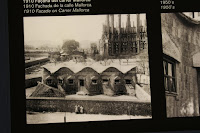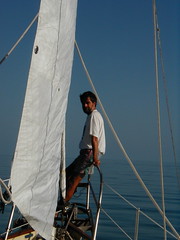 Having read and heard so many times about how amazing this city is, we had to go see for ourselves.
Having read and heard so many times about how amazing this city is, we had to go see for ourselves.We had an excellent location for our apartment in Bari Gothic, 2 minutes from Las Ramblas and its treasures...one of them the market La Boqueria. Oh! so much abundance, colours, aromas!
Marzipan!!!!!!!!!Jujubes!!!!!!
The day after our arrival, we made ourselves on the discovery trip of some of the most popular Gaudi buildings.
Here is Casa Calvet, the most conventional of his buildings...
And below is Palau Gruell, located on such a narrow street of the Raval neighbourhood that we had a hard time looking at and taking a picture of the entire building!!!
Casa Batlo was definitely striking ...
Even more so at night...
 La Pedrera, another internationally known Gaudiesque realization was certainly worth the visit! La Pedrera (1905) also known as Casa Mila (its original name as it was designed for the wealthy Mila family) can be found on Passeig de Gràcia. The word "Pedrera" means "Quarry" and was used locally to describe the building because of its stone like appearance. At first sight, it might be less stunning than Casa Batlo but a more in-depth visit of its roof and its interior revealed a real architectural gem!The most stunning aspect of this quite large residential apartment building is that every part of the building (inside and outside) has been thought through by Gaudi!
La Pedrera, another internationally known Gaudiesque realization was certainly worth the visit! La Pedrera (1905) also known as Casa Mila (its original name as it was designed for the wealthy Mila family) can be found on Passeig de Gràcia. The word "Pedrera" means "Quarry" and was used locally to describe the building because of its stone like appearance. At first sight, it might be less stunning than Casa Batlo but a more in-depth visit of its roof and its interior revealed a real architectural gem!The most stunning aspect of this quite large residential apartment building is that every part of the building (inside and outside) has been thought through by Gaudi! Its roof was spectacular...again, each perspective was planned: as can be seen below, some perspectives offered views of La Sagrada Familia and below, a view of another basilica located on the mount Tibidabo.
Its roof was spectacular...again, each perspective was planned: as can be seen below, some perspectives offered views of La Sagrada Familia and below, a view of another basilica located on the mount Tibidabo.
And the roof!!! Called "the garden of warriors" by the poet Pere Gimferrer, it has twenty-eight chimneys in several groupings twisted so that the smoke can come out more easily, half-hidden vents whose function is to renew the air in the building, with all those structures crowning the walkway around this dream castle, as well as snail-shaped staircases that house water tanks!

As the interior is full of round walls and structures, future tenants were worried that their furniture would not fit anywhere. Gaudi is known to have told Mr. Mila's wife who complained about her piano not fitting in that she might have to switch to another instrument! These two did not have a very good relationship and disagreed quite a bit about the design of the building. As soon as Gaudi died, Madame Mila made several changes to the interior including the eradication of amazing curved ceilings. In 1990, when Safety of Catalonia acquired La Pedrera to initiate another series of restoration works, some of the original decorations re-emerged. We think that we could easily adapt to living there, not only we do not play piano but Heiner said he would be willing to build roundish furnitures!!!

After such an exhausting (!) intellectual experience, we felt like resting and enjoying an apero at the wonderful bar El Nacional! We had local vermuth! with local olives!at local prices!!!
We devoted half a day to Gaudi's monumental La Sagrada Familia. Luckily, we had boughts tickets online...
 In a nutshell, the construction of this basilica began in 1882 and Gaudí became involved in 1883 after the first architect’s resignation. Combining Gothic and curvilinear Art Nouveau forms, Gaudí created a magnificent and quite original church, spending his last years living and sleeping in the building while supervising its construction. At the time of his death 1926, barely a quarter of the project was complete. The Sagrada Família's construction relied only private funding and has been controversial throughout the years, also being hampered during the Spanish Civil War, only to slowly resume in the 1950's. In recent years, computer technology has speeded the evolution of the construction and it is hoped that it will be completed in 2026, the centenary of Gaudí's death.
In a nutshell, the construction of this basilica began in 1882 and Gaudí became involved in 1883 after the first architect’s resignation. Combining Gothic and curvilinear Art Nouveau forms, Gaudí created a magnificent and quite original church, spending his last years living and sleeping in the building while supervising its construction. At the time of his death 1926, barely a quarter of the project was complete. The Sagrada Família's construction relied only private funding and has been controversial throughout the years, also being hampered during the Spanish Civil War, only to slowly resume in the 1950's. In recent years, computer technology has speeded the evolution of the construction and it is hoped that it will be completed in 2026, the centenary of Gaudí's death.The church shares its site with the Sagrada Família school, a building originally designed by Gaudí in for the children of the church workers. It was relocated in 2002 from the eastern corner of the site to the southern corner. Why a school? because at that time, the current site of Sagrada Familia was a no man's land! Difficult to believe this today with the church being surrounded by populous neighbourhoods!
After spending several hours on the premises, we could only agree with art critics and millions of impressed visitors: Sagrada Familia is unique! There is no other church like it, and Gaudi is a genius! As art critic Paul Goldberger called it,it is the most extraordinary personal interpretation of Gothic architecture since the Middle Ages.
 It was intriguing to learn where Gaudi found his inspiration: as a young boy, he was often sick and spent most of his childhood with his mother, going on nature walks, being fascinated with plants and animals. He was ahead of his time, integrating organic shapes in architectural design...
It was intriguing to learn where Gaudi found his inspiration: as a young boy, he was often sick and spent most of his childhood with his mother, going on nature walks, being fascinated with plants and animals. He was ahead of his time, integrating organic shapes in architectural design...We were surprised to see how easy it was to walk to most of Barcelona's sights from our apartment. One can spend hours in Bari Gothic to visit its many sights. We especially liked the Cathedral of Barcelona, La Seu, Placa del Rei and the Ajutament de Barcelona, and of course the Placa Reial where we often went for a late night glass of Sangria!
It is here, on those stairs of the Square of the Placa del rei, that Christopher Columbus was greeted by the Catholic Kings Ferdinand and Isabella on his triumphant return from his famous voyage to the Americas. Despite the ambivalence that one may feel regarding Columbus mission to the Americas, it was nevertheless pretty impressive to think of this scene!
And yes, Columbus is honored here once more at the foot of Las Ramblas with this monumental column. El Mirador de Colon which commemorates his visit to Barcelona in 1493.
Port Vell was a place that we often went to for sitting in the sun, looking at the big ferries linking Barcelona to the Balearic islands, walking around the marinas...
Here is La Rambla del Mar....leading to the Maremagnum shopping centre
We loved this floating sculpture of a human figure looking at the stars and holding one behind its back...Miraestels by the Catalan artist Robert Llimos. In the background behind the ship is the World Trade Centre.
Schooner Santa Eulalia, exhibit of the Barcelona Maritime Museum.
And the marina...
We spent 3 hours there but did not make it to the 17th century!!! Nevertheless, we loved the exhibits and learned a lot about the history of Catalunya! http://www.en.mhcat.cat/content/view/full/96
In terms of contemporary cultural/historical displays, we missed the popular dance La Sardana which usually takes place on the placa near the cathedral during the weekend. However, we went to a street parade with local acrobats The Falcons, whose special talent is this Catalan human pyramid! There was a wonderful family atmosphere with long tables where children were drawing pictures and making an installation, the local restaurants were full and there was the parade!
Should you want to know more about this ancient tradition: https://en.wikipedia.org/wiki/Castell
On Sunday, we joined locals in the Parc de la Ciutadella. The largest green space of the city, it gave us an authentic local experience away from the tourist crowd!
The park also hosts the seat of the Catalan government!
We explored another type of popular area, mostly curious about this Torre de Agbar building that is synonymous of Barcelona!
The Torre Agbar is a 38-story skyscraper located in the Poblenou neighbourhood of Barcelona
which marks the gateway to the new technological district of Barcelona. Named after its owners, the Agbar Group, this office building (30,000 of them!!!!!) was designed by French architect Jean Nouvel in association with the Spanish firm b720 Fermín Vázquez Arquitectos and built by Dragados at the cost of 130 million euros!
On our way to this strange modern monument, we explored the Mercat del Encants. This is the largest of Barcelona flea markets. It was amazing to see the piles of clothing, shoes, and other items piling up on the floor! Who would have the courage to dig into this rubbish???? There were other stands with all imaginable stuff...a real experience!
 The cafeteria was not inviting..so we walked quite a long time before finding a place to eat. We found a small restaurant of El Born neighbourhood that soon became one of our favorites! Tapas, of course, beer, vermuth, wines...in a very vibrant atmosphere! The tapas were really delicious and make of that place one of the most popular tapas bar of this district of Barcelona!
The cafeteria was not inviting..so we walked quite a long time before finding a place to eat. We found a small restaurant of El Born neighbourhood that soon became one of our favorites! Tapas, of course, beer, vermuth, wines...in a very vibrant atmosphere! The tapas were really delicious and make of that place one of the most popular tapas bar of this district of Barcelona!Walking through the popular Barceloneta area, with its numerous Catalan gold and red flags hanging from several balconies.
And El Peix, sculpture of Frank Gehry, the giant golden fish that became the symbol of post-olympic Barcelona!
And the Mediterranean: a soft and windless seascape on that particular evening.

 There are so many way to spend beautiful evenings in Barcelona; this is a view of Placa Reial, close to our apartment, where we often enjoyed a late night sangria!
There are so many way to spend beautiful evenings in Barcelona; this is a view of Placa Reial, close to our apartment, where we often enjoyed a late night sangria!































































































